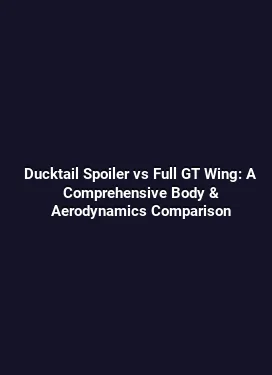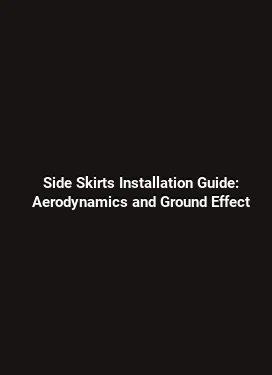Body & Aerodynamics: In-Depth Exploration Across 25 Topics
Foundations of Body & Aerodynamics

At the heart of vehicle performance lies the interplay between the exterior form and the turbulent world it moves through. Aerodynamics is not merely about making something look sleek; it is the systematic management of airflow to reduce resistance, improve stability, and harness downforce where needed. From the first sketches to the final wind tunnel tests, the goal is to balance drag reduction with functional downforce, cooling, and packaging constraints. Critical concepts include drag coefficient, lift forces, flow separation, viscosity, and boundary layer behavior. Real-world progress emerges when engineers translate these principles into precise surface detailing, underbody architecture, and active or passive flow-control strategies.
In modern automotive and aerospace contexts alike, numerical simulation and experimental validation work hand in hand. Computational fluid dynamics (CFD) provides a virtual lab for iterating designs, while wind tunnels and track testing verify Reynolds number effects and scale-corrected performance. The evolution of body aerodynamics often hinges on surface finish, geometric transitions, and the subtle management of vortices that originate at edges, edges, and discontinuities. The 25 topics below unfold across design philosophy, practical techniques, and case studies that demonstrate how theoretical concepts translate into tangible performance gains.
Surface Geometry and Its Influence on Drag
The surface geometry of a body determines how air adheres, detaches, and reattaches as it flows along the exterior. Gentle, continuous curves minimize abrupt separation; sharp edges can be beneficial when used strategically to shed wake or promote desired vortex structures. The shape of a nose, hood, roofline, and rear end collectively dictates the pressure distribution along the body. A smooth transition between surfaces reduces form drag, while carefully introduced sculpting—such as a concave roofline or a pronounced tail—can shape the wake for downstream efficiency. Surface roughness is another lever: infinitesimally small textures can trip the boundary layer, affecting transition and friction coefficients in ways that improve or degrade overall performance depending on the intended operating envelope.
Practical takeaway: aim for continuity of flow across junctions and minimize abrupt diameter changes. For high-speed cars, consider a blended nose with a gradual reduction in cross-sectional area and a rear that encourages a stable, narrow wake. For everyday vehicles, practical gains come from clean door handles, mirror integration, and the elimination of protrusions that interrupt the boundary layer without providing compensating benefits.
Flow Control Fundamentals

Flow control strategies can be passive or active. Passive methods rely on geometry and surface features to manipulate the air without actuators, while active methods use sensors, controllers, and mechanisms to modify the flow in real time. Classic passive devices include spoilers, diffusers, side skirts, and underbody panels. These elements shape the near-wall flow to delay separation, generate downforce where needed, or reduce drag by streamlining the wake. Active aero systems—such as adjustable tailplanes, movable spoilers, or active canards—can adapt to changing speeds and load conditions, offering a balance between drag reduction at highway speeds and downforce during high-load maneuvers.
Designers carefully consider the energy cost and reliability of active systems. The benefits must outweigh the power required to operate actuators and the potential for added mass or complexity. In racing and performance vehicles, active aero is common; in everyday cars, passive optimization often delivers the best overall value and simplicity.
Boundary Layer Behavior and Transition
The boundary layer represents the thin region of fluid that adheres to the surface of a body. Within this layer, viscous forces dominate, shaping shear stresses and frictional drag. Two regimes matter: laminar flow, which minimizes skin friction but is highly sensitive to surface imperfections, and turbulent flow, which resists separation better at certain angles of attack but increases friction. The transition from laminar to turbulent flow is a critical design consideration because it can dramatically alter drag and stability characteristics. Engineers aim to extend laminar flow where feasible, then manage transition in a controlled manner to prevent premature separation.
Practical cues involve surface quality, alignment of panels, and minimal corner radii. Smooth, well-finished surfaces reduce unfriendly roughness that can prematurely trip the boundary layer. On the other hand, purposeful roughness or micro-texturing can be used to promote a stable transition under specific conditions, such as high-speed cruising or off-design loads, but this requires careful calibration and testing to avoid unintended penalties in other regimes.
Laminar-Turbulent Transition in Real-World Scenarios
In real-world driving, ambient turbulence, surface contamination (dust, rain, ice), and component interactions undoubtedly influence transition. The goal is not to achieve perfect laminar flow over the entire body, but to orchestrate a favorable boundary layer that remains attached over critical regions and minimizes flow separation at the trailing edge. For example, at high speeds, a well-designed front fascia can delay separation along the roof line, producing a smoother tail wake and reducing drag. In pursuit of performance, engineers often employ surface sensors and CFD to map how local roughness or curvature affects the laminar-to-turbulent transition along the vehicle silhouette.
Underbody Philosophy: Flattened Floors and Channeling Air
The underbody of a vehicle is a powerful contributor to downforce generation and drag reduction. Smooth, uninterrupted panels create a low-friction path for air to pass beneath the car, reducing underside turbulence. In performance-focused applications, flat floors and strategically shaped diffusers guide the flow rearward, promoting a coherent wake and aiding stability. The interaction between underbody airflow and diffuser geometry can dramatically affect downforce distribution without imposing excessive drag penalties. A well-designed underbody also supports cooling strategies by providing channels that direct air toward radiators and brakes, enhancing thermal management without compromising aerodynamics.
Implementation considerations include manufacturing feasibility, impact on ground clearance, and maintenance access. Real-world programs balance the benefit of underbody aerodynamics with practical constraints such as debris exposure and low-speed ride quality. Smooth fasteners, flush-mounted panels, and carefully recessed edges are often employed to minimize flow disruption while preserving serviceability.
Diffusers, Vanes, and Wake Management
Diffusers accelerate air as it exits under the rear of the vehicle, lowering pressure and increasing downforce. Their effectiveness depends on proper angle, width, and the continuation of a consistent floor surface into the rear. Vanes and strakes can be used to direct flow from the sides toward the diffuser, aiding the development of a stable, predictable wake. The net effect is a reduction in turbulent energy in the rear region, which translates to lower drag and improved high-speed stability. However, misapplied diffuser designs can trap recirculating air or create adverse pressure gradients, so simulation and wind-tunnel validation are essential during development.
Front-End Design, Cooling, and Airflow Paths
Front-end geometry serves multiple purposes: it sets the initial pressure distribution, determines how air is channeled to radiators and brakes, and influences the overall drag. A clean, well-posed front end reduces adverse pressure buildup on the windshield and reduces lift tendencies at high angles of attack. Sophisticated intake systems blend into the bodywork so that cooling needs are met without imposing excessive aerodynamic penalties. Grille openings, bumper lobes, and hood grilles can be engineered to optimize the trade-off between cooling efficiency and drag, using active shutters or flow-directing surfaces to adjust to engine load and ambient conditions.
In high-performance contexts, the alignment of the radiator core, condenser, and intercooler pathways is planned to maximize cooling while minimizing interference with external flow. CFD and wind tunnel tests help verify that pressure recovery in the front remains favorable and that the boundary layer remains well-behaved across a range of speeds.
Cooling Pathways and Surface Integrity
Efficient cooling requires thoughtful ducting, minimal interferences with external flow, and protection against debris. The layout of ducts from the grille to the radiator, along with any active cooling devices, must be robust against off-design conditions such as heavy rain or snow. Surface integrity matters as scratches or defects can disrupt laminar flow on the front surface, subtly compromising overall aerodynamic performance. Engineers often employ scalloped edges, baffling, and carefully designed turn radii to ensure that cooling requirements are met without incurring unnecessary aerodynamic costs.
Roll, Pitch, Yaw: Stability Through Aerodynamics
Aerodynamic stability encompasses how a vehicle responds to perturbations caused by steering input, wind gusts, or changing road conditions. The distribution of lift and downforce across the vehicle height and width influences its pitch, roll, and yaw characteristics. A well-balanced aerodynamic package provides a stable baseline during straight-line cruising and predictable handling in cornering. Designers tune the center of pressure and the downforce gradient to avoid overpowering the tires with excessive load transfer or diminishing grip in critical steering moments.
Practical approaches include distributing downforce where it most benefits load transfer control, avoiding abrupt shifts in lift across the vehicle that could lead to instability. In motorsports, active aero can dynamically adjust to stance and track conditions, enhancing cornering speeds while keeping the overall drag penalty under control.
Downforce Distribution Strategies
Downforce distribution involves balancing fore and aft forces to optimize grip on all four corners. A forward-biased downforce helps with steering precision, while rear-downforce improves straight-line stability and braking. Achieving the right balance often requires a combination of front splitters, side skirts, and rear diffusers, with careful attention to crosswinds and vehicle mass distribution. The end goal is to achieve a predictable, scalable response that remains consistent across a range of speeds and load conditions.
Surface Treatments and Finishes
Surface finishes influence skin friction and flow separation. Polished, low-roughness surfaces help reduce drag by minimizing microscopic roughness that can trip the boundary layer. Conversely, certain micro-textured or patterned surfaces can be used judiciously to promote controlled transition or to manage heat transfer, depending on operational requirements. The choice of paint, clear coats, and protective films also interacts with aerodynamics by affecting how contaminants accumulate and how the surface interacts with the boundary layer over time. Maintenance practices, such as regular washing and protection from road debris, support sustained aerodynamic performance.
Materials, Finish, and Durability
Material selection for aerodynamic components balances stiffness, weight, and durability. Composites, carbon fiber, aluminum, and high-strength steels each offer unique advantages for shaping complex geometries like canards or rear diffusers while withstanding aerodynamic loads. Finishes must resist UV exposure, stone impacts, and chemical exposure from de-icing agents or road salt. The finish quality can also subtly influence long-term moisture behavior and surface texture, which in turn affects the boundary layer interactions integral to drag and lift management.
Active Aero: Sensing, Control, and Adaptation
Active aero systems respond to dynamic conditions such as speed, yaw, and chassis load. Sensors feed a control system that adjusts elements like spoiler angle, vane positions, or underbody flaps to maintain an optimal aerodynamic state. The primary benefit is the ability to optimize performance across a broad operating envelope—from city streets to racetrack runs. However, the power consumption, system complexity, and potential reliability concerns require rigorous testing and robust fail-safes. In production vehicles, active aero is often reserved for specific models or trim levels where performance and efficiency targets justify the added system cost.
Implementation Scenarios and Validation
Successful active aero requires a careful integration of sensors, actuators, and control algorithms. Validation happens across CAD-based simulations, CFD, wind tunnel experiments, and route-to-market testing under real-world conditions. Engineers also consider redundancy and ease of maintenance, ensuring that the system remains reliable under typical road hazards and climate conditions. The end result is a dynamic aerodynamic profile that enhances fuel efficiency, cornering stability, and high-speed safety without introducing undue complexity.
Case Studies: Real-World Applications
Case studies illustrate how aerodynamic principles translate into measurable performance gains. A high-performance sedan may employ a refined front-end undertray, a precision-tailored diffuser, and an adaptive rear wing to balance cruising efficiency with track-ready downforce. A compact urban vehicle could benefit from a streamlined underbody cover and side-sill spoilers that quietly reduce drag, improving fuel economy and ride stability. In aerospace-inspired applications, the boundary layer management on airframes, the alignment of intakes with engine cooling needs, and the use of canards or tailplanes demonstrate how aerodynamic thinking permeates design choices at multiple scales.
Takeaways from Industry Examples
Across industries, the recurring theme is optimization through integrated design. Each surface, each junction, and each flow path is a potential lever to improve efficiency, handling, or cooling. The most successful programs treat aerodynamics as a holistic discipline—one that harmonizes form, function, and manufacturability—rather than a collection of isolated features. The practical benefit for designers and engineers is a clearer framework for decision-making, enabling more confident trade-offs and faster iteration cycles.
In summary, the evolution of body and aerodynamic design rests on understanding how air behaves around complex geometries, how to manage boundary layers, and how to deploy a combination of passive and active strategies to achieve performance goals without compromising reliability or usability. By embracing the full spectrum—from surface finish to underbody architecture and active control—design teams can deliver vehicles that are not only faster or more efficient, but also safer and more enjoyable to drive across diverse scenarios.






